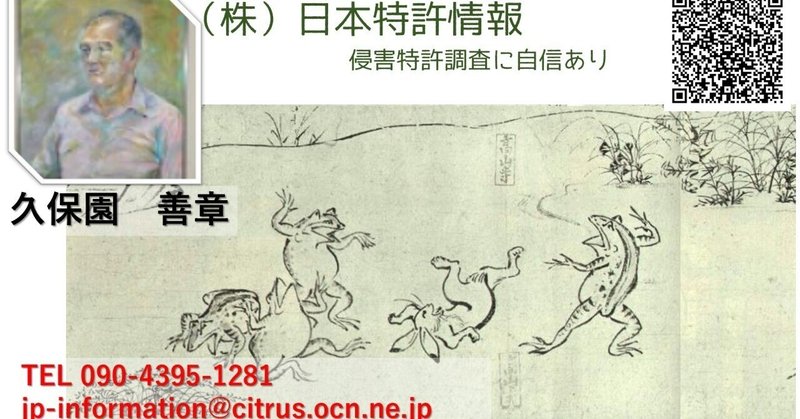
控訴人( 原告)の請求棄却(控訴人(原告)=アイリスオーヤマの権利無効)。 知的財産高等裁判所により「権利無効」とされた新106件目のものです。
https://drive.google.com/file/d/1ChQoXDX360LeVGxoQS2buPoWXbWtDWab/view?usp=sharing
特許権者である控訴人(原告)のアイリスオーヤマ株式会社は、自分が保有する特許第3,797,900号(加熱処理システム,加熱調理器および換気ファン装置)他1件について、その特許の「有効性」を検証したか不明です。
「有効性」とは、自社の特許についての、例えば「無効資料調査」等を行うことで、たとえ利害関係者などの第三者からの「無効審判」を起こされても、自社の特許は盤石であると確信することです。
それにも拘らず、特許庁より与えられた特許を有効と信じて、日立アプライアンス株式会社を特許侵害している、と提訴しました。
しかしながら、東京地方裁判所は、「本件発明2-1及び同2-2は,いずれも,本件出願日2前に,当業者が引用発明2に上述した周知の構成ないし周知技術を適用し,又は適宜設計することにより,容易に発明をすることがきたものと認められる。いずれも特許無効審判により無効にされるべきものと認められるから,原告は,被告に対し,本件特許権2を行使することができない。」とし、結局、原告は敗訴しました。
そして、知的財産高等裁判所は、「本件訂正発明2は,当業者が引用発明2に乙5及び6の各公報に記載された技術的事項を適用し,適宜設計することにより,容易に発明をすることができたものといえる。原判決は相当であるから,本件控訴を棄却することとして,主文のとおり判決する。」とし、結局、損害賠償金を得ることができませんでした。
また、その根拠として、「引用発明2」を先行技術文献として挙げています。
「引用発明2」とは、「乙4公報」で、「EP1010949」です。
この文献は、特許庁の審査段階では見つけることが出来なかったものです。
特許庁の指導者(大森藏人)のもとで、検索者(幸川順一)が行った、【検索論理式】に基づきた(サーチ)では見つけることが出来ていません。
それもそのはず、彼らは日本特許のみをその調査対象としたようです。
調査の範囲を外国、特に米国やEPに広げるべきであったと考えます。
そんなこんなで、出願人は、みごと「特許査定」を勝ち取りました。
しかしながら、特許権利者は東京地方裁判所および知的財産高等裁判所において上記のように敗訴しました。
本件の根本原因は、特許庁の審査官が、東京地方裁判所で示された「EP1010949」を、探し当てることができなかったことにあります。
ちなみに、上記の「EP1010949」に付されているIPCは「 F24C 15/20」で、その内容は「・調理時のくん煙の除去」です。
この分類は、本件特許公開(特開2003-083550)には付与されていません。
特許庁の「分類付与」もいい加減なものですね。
特許庁の審査官のいい加減な(サーチ)に基づいた、特許付与は許されません。
特許庁の審査官が、出願人のに特許を与えたことにより、以後の出来事が如何にネガティブな事態となって行ったかが理解できます。
ここで、本件特許公開(特開2003-083550)の「出願情報」のうち「FI」と「Fターム」を、本エクセル資料の2シート目以降に挙げておきました。
更にまた、「検索用語・分類(FI、Fターム)の選定 と 検索論理式の作成」、「その具体例」、「登録調査機関の検索者が行った、不十分で、的外れな「論理検索式」による(サーチ)」、「登録調査機関(株式会社AIRI)の検索者が見つけることのできなかった特許文献」などの資料を添付します。
https://drive.google.com/file/d/1Q3hHuHFHCHNlr3A0CRYVKYfpiNTPWUjB/view?usp=sharing
(Google Translation)
The claim of the appellant (plaintiff) was dismissed (the rights of the appellant (plaintiff) = Iris Ohyama were invalidated).
This is the 106th new case that has been declared "invalid" by the Intellectual Property High Court.
The appellant (plaintiff), Iris Ohyama Co., Ltd., which is the patentee, has filed a lawsuit regarding patent No. 3,797,900 (heat treatment system, heating cooker and ventilation fan device) and one other patent that it owns.
It is unclear whether "effectiveness" has been verified.
"Validity" means that even if an "invalidation trial" is filed by a third party such as an interested party, the company's patent will remain valid by conducting, for example, "invalidation material investigation" regarding the company's patent.
Be sure that it is rock solid.
Despite this, the company believed that the patent granted by the Japan Patent Office was valid and filed a lawsuit against Hitachi Appliances, Inc., accusing it of infringing the patent.
However, the Tokyo District Court stated that ``Both Inventions 2-1 and 2-2 are the result of a person skilled in the art applying the above-mentioned well-known structure or well-known technology to Cited Invention 2 before the filing date of the present case, or It is recognized that the invention could have been easily made by designing it appropriately.Since it is recognized that both should be invalidated by a patent invalidation trial, the plaintiff should exercise Patent Right 2 against the defendant.
In the end, the plaintiff lost the case. The Intellectual Property High Court stated that ``Corrected Invention 2 can be easily invented by a person skilled in the art by applying the technical matters described in Otsu No. 5 and 6 to Cited Invention 2 and designing it appropriately.
As the original judgment was appropriate, we hereby render the judgment as stated in the main text, dismissing the appeal in this case.''
In the end, the court was unable to obtain compensation for damages. Furthermore, as the basis for this, "Cited invention 2" is cited as a prior art document. "Cited invention 2" is "Otsu 4 Publication" and is "EP1010949".
This document could not be found at the patent office's examination stage.
It has not been possible to find it through a search based on the [search logical formula] conducted by the searcher (Junichi Yukikawa) under the guidance of the Patent Office instructor (Kurato Omori).
As expected, they only targeted Japanese patents.
We believe that the scope of the investigation should have been expanded to foreign countries, especially the United States and the EP.
In this way, the applicant was able to successfully obtain a patent grant.
However, the patentee lost the case at the Tokyo District Court and the Intellectual Property High Court as described above.
The root cause of this case is that the patent office examiner was unable to locate "EP1010949" as presented at the Tokyo District Court. By the way, the IPC attached to the above "EP1010949" is "F24C 15/20", and its content is "・Removal of fumes during cooking".
This classification has not been assigned to this patent publication (Japanese Patent Application Laid-Open No. 2003-083550).
The Japan Patent Office's "classification" is also sloppy.
Granting a patent based on a sloppy search by a patent office examiner is unacceptable.
You can understand how the patent office examiner granted the patent to the applicant, and the subsequent events turned into a negative situation.
Here, we have listed "FI" and "F term" of the "application information" of this patent publication (Japanese Unexamined Patent Publication No. 2003-083550) from the second sheet of this Excel document.
Furthermore, we will discuss ``selection of search terms and classifications (FI, F-terms) and creation of search logical formulas,'' ``concrete examples,'' and ``inadequate and irrelevant ``logical searches conducted by searchers at registered research organizations.''
Attach materials such as "(search) by formula" and "patent documents that the searcher of the registered research organization (AIRI Co., Ltd.) could not find."
(Google 翻译)
驳回上诉人(原告)的诉讼请求(上诉人(原告)=大山爱丽丝的权利无效)。
这是第106起被知识产权高等法院宣布“无效”的新案件。
上诉人(原告)作为专利权人的Iris Ohyama Co., Ltd.就其拥有的第3,797,900号专利(热处理系统、加热烹调器和换气扇装置)及其另一项专利提起诉讼。
不清楚“有效性”是否得到验证。
“有效”是指即使利害关系人等第三方提出“无效审判”,通过对公司专利进行“无效宣告材料调查”等,该公司的专利仍然有效。坚如磐石。
尽管如此,该公司仍认为日本专利局授予的专利有效,并对日立电器提起诉讼,指控其侵犯该专利。
然而,东京地方法院表示, “发明2-1和2-2都是本领域技术人员在申请前将上述公知结构或公知技术应用于引证发明2的结果”本案的日期,或者 认识到该发明通过适当的设计是可以很容易地实现的。
由于认识到两者都应通过专利无效审判而宣告无效,因此原告应对被告行使专利权2。
最终,原告败诉。
知识产权高等法院表示, “通过将大津第5号和第6号中描述的技术事项应用于引证发明2并进行适当设计,本领域技术人员可以容易地发明更正发明2。
”适当,特作出正文所述判决,驳回本案上诉。”
最终,法院未能获得损害赔偿。
此外,作为其基础,引用了“引用发明2”作为现有技术文献。 “引用发明2”是“大津4公开”并且是“EP1010949” 。
该文件在专利局审查阶段未能找到。
检索员(幸川纯一)在专利局指导员(大森仓人)的指导下,根据[检索逻辑式]进行检索,未能找到。
不出所料,他们只针对日本专利。
我们认为调查范围应该扩大到国外,特别是美国和欧洲议会。
至此,申请人得以顺利获得专利授权。
然而,如上所述,专利权人在东京地方法院和知识产权高等法院败诉。
本案的根本原因是专利局审查员无法找到向东京地方法院提交的“EP1010949” 。
顺便说一句,上述“EP1010949”附带的IPC是“F24C 15/20” ,其内容是“·烹饪过程中的油烟去除”。
该分类尚未分配给本专利公开(日本专利申请公开No.2003-083550) 。
日本专利局的“分类”也很马虎。
根据专利局审查员草率的检索授予专利是不可接受的。
您可以了解专利局审查员如何将专利授予申请人,以及随后的事件转变成不利的情况。
这里,我们从该Excel文档的第二页列出了该专利公开(日本未审专利公开No.2003-083550)的“申请信息”的“FI”和“F项”。
此外,我们将讨论“搜索项和分类(FI、F 项)的选择以及搜索逻辑公式的创建”、“具体示例”以及“搜索者进行的不充分且不相关的逻辑搜索”附上“(通过公式检索)”和“注册研究机构(AIRI有限公司)的检索者无法找到的专利文献”等材料。
(ハッシュタグ)
#INPIT #JPlatPat #仕事について話そう #note #note毎日更新 #note毎日投稿 #note連続更新 #note連続投稿 #noteクリエイター #note応援部 #note毎日 #note海外組 #noteメンバーシップ #note日記 #note更新 #noteサークル #仕事 #仕事のコツ #仕事のポリシー #仕事論 #仕事効率化 #仕事観 #仕事ができる人 #仕事の話 #仕事内容 #仕事の仕方 #仕事の進め方 #仕事を楽しむ #仕事とは #仕事力 #ビジネス #ビジネススキル #ビジネスモデル #ビジネスチャンス #知財 #知財戦略 #知財塾 #知的財産 #知的財産権 #知的財産高等裁判所 #特許 #特許調査 #特許法 #特許庁 #特許事務所 #特許分類 #特許検索 #特許分析 #特許情報 #特許権者 #特許無効審判 #専利 #分類付与 #先行技術調査 #無効資料調査 #侵害調査 #侵害予防調査 #パテント #発明 #発明塾 #どうする特許庁 #検索論理式 #審査官 #審判官 #AI #AIの活かし方 #AI画像生成 #IT #ITエンジニア #IT業界 #IT企業 #ITベンチャー #IT化 #IT系 #ITリテラシー #ITツール #DX #DX化 #DX推進 #DX人材 #DX事例 #DXリテラシー #Patent #ChatGPT #ChatGPTの使い方 #ChatGPTが凄い #ChatGPTに聞いてみた #Chatgpt4 #Gemini #Threads #bing #bingAI #bingX #金子吉友 #一月万冊 #裁判所 #出願情報 #東京地方裁判所
この記事が気に入ったらサポートをしてみませんか?
